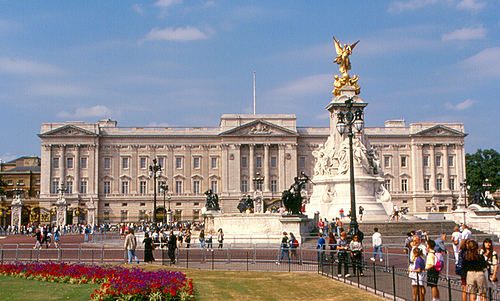Buckingham Palace
Buckingham Palace currently serves as the administrative headquarters of the monarch and has been the official London residence of Britain’s Royalty since 1837.
Although in use for the many official events and receptions held by The Queen, the State Rooms at Buckingham Palace are open to visitors every year.
Buckingham Palace has 775 rooms including 78 bathrooms, 92 offices, 188 staff bedrooms, 53 Royal and guest bedrooms, and 19 State rooms. The building is 24 meters tall, 120 meters deep and 108 meters long across the front.

The Palace is the centerpiece of Britain’s constitutional monarchy and very much a working building. It houses the offices of those who support the day to day duties and activities of The Duke of Edinburgh and the Queen and their immediate families.
The Palace is also the venue for great Investitures, State Visits, and Royal ceremonies, all of which are organized by the Royal Household.
Although Buckingham Palace is furnished and decorated with priceless works of art that form part of the Royal Collection, it is neither a museum nor an art gallery.
More than 50,000 people visit the Palace each year as guests to dinners, lunches, receptions, and banquets, and the Royal Garden Parties.
Sometimes used as a second dancing room during Queen Victoria’s reign for various Court gatherings, the Throne Room has a large arch which is supported by two winged figures.
George IV’s palace originally lacked a large room in which to entertain. In 1853 through 1855 Queen Victoria corrected that shortcoming by adding the largest room in London at the time of its construction.
Along the East Gallery is where The Queen and her State guests proceed to the Ballroom for State Banquets which are normally held on the first day of the visit.
Around 150 guests are invited and include High Commissioners and Ambassadors, members of the Royal Family, and other prominent people who have associations or with the visiting country.
The Ballroom has been used variously for performances of the arts, as a concert hall for memorial concerts, and is the normal venue for Investitures of which there are usually 21 a year including ten in autumn, two in summer, and nine in spring.
At Investitures, The Queen (or her majesty’s representative, The Prince of Wales) will meet those receiving British honors, including awarding knighthoods.
From the Ballroom, the West Gallery leads into the one of the first great rooms which overlook the formal gardens which are the setting for the annual Garden Parties that were introduced in 1868 by Queen Victoria.
One of the principal State Rooms on the West side of the Palaces the State Dining Room. Numerous people of note have dined in this room including the 24 holders of the Order of Merit as well as prime ministers and presidents.
The 1850s, the first State Ball was held in the Blue Drawing Room in May 1838 as part of the celebrations leading up to Queen Victoria’s Coronation. This was prior to the Ballroom being added in the 1850s.
Originally known as the Bow Drawing Room, the Music room is the center of the suite of rooms on the Garden Front between the White and Blue Drawing Rooms.
Four Royal babies, Prince William, the Duke of York, the Royal Princess, and the Prince of Wales were all christened in the Music Room by the Archbishop of Canterbury.
The White Drawing Room is the last of the suite of rooms that overlook the gardens on the main floor. It was originally called the North Drawing Room and is perhaps the grandest of all the State Rooms. The Room is also used as a Royal reception room for members of the Royal family and The Queen to gather before official State occasions.
Guests pass through The Bow Room on their way to the Royal Garden Parties on their way to the garden. The Queen holds the lunch for an arriving Head of State at the beginning of a State visit.

